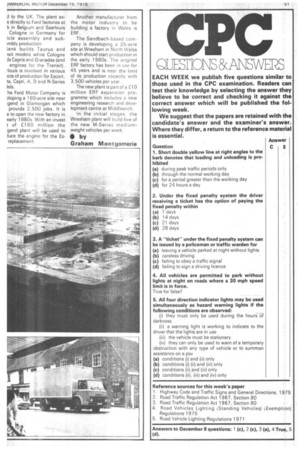From Dagenham to Swansea Bay
Page 52

Page 53

If you've noticed an error in this article please click here to report it so we can fix it.
THE FORD factory at Swansea has one advantage over Dagenham, Langley, Brentwood and the rest in that it enjoys a view of the sea. Situated on the outskirts of Swansea, the site was acquired in June 1965 from a company which had been making refrigerators — Prestcold. Six months later work began on building axles for the whole Ford range of passenger cars and commercial vehicles.
Originally, the area of the site was 94 acres, but this has been increased by the acquisition of adjacent premises belonging to a steel fabricator which has put the area over the 100-acre mark. The manufacturing floor space is 102,000sqm (around 1.1 million sqft).
In 1977, Ford spent £500,000 for equipment to make the brake drums used on all Escort, Capri and Cortina models. Still on the braking side, discs for the Cortina are also made there. As far as the commercial side is concerned, Swansea is heavily involved in brake production for the Transit and the A-Series.
Rear axles
Each day, the 1,300 Ford workers produce more than 1,200 axles for the Escort and Capri, over 600 for the Cortina and more than 300 for the Transit. Swansea in fact accounts for all the axles used in the production of shortwheelbase Transits while the West German plant at Duren makes the others.
Moving up the weight range, crown wheel and pinion sets for A, D and N-series (the German 0-Series basically) are made at a production rate of 150 per day. These are of the single-speed type ranging from 4.3 to 10.2 tonnes capacity with spiral bevel or hypoid gearing depending on the individual application.
Ford's all-synchromesh gearbox in four, six and eightspeed form is supplied from Swansea — over 200 are produced every day. This gearbox series has been so designed to enable all the variants to use the same casing.
Two versions of the six-speed box are produced with one each for the four and the eight. Recipients of the box are the A, D and N-Series from Ford.
Raw materials for the Swansea plant arrive by road and rail — the factory has 2.4km (11/2 miles) of railway track — from outside supplies and other company locations. As a matter of interest, Ford is British Rail's biggest customer. Dagenham Forge and Thames Foundry supply nearly all the forgings and castings which Swansea machines.
The finished assemblies ar the main components are shi ped out by road and rail Dagenham and Halewood f assembly into the cars and Langley and Southampton f the commercials. The massi, parts centre at Daventry is n forgotten.
Swansea output is not co d to the UK. The plant ex s directly to Ford factories at k in Belgium and Saarlouis Cologne In Germany for icle assembly and subwhbly production.
ienk builds Taurus and tsit models while Cologne ds Capris and Granadas (and engines for the Transit), rlouis is involved in various )cts of production for Escort, ta, Capri, A, D and N-Series lels.
'he Ford Motor Company is eloping a 180-acre site near Igend in Glamorgan which provide 2,500 jobs. It is e to open the new factory in early 1980s. With an invest t of £180 million the Igend plant will be used to luce the engine for the Esreplacement. Another manufacturer from the motor industry to be building a factory in Wales is ERF,
The Sandbach-based company is developing a 25-acre site at Wrexham in North Wales which should start production in the early 1980s, The original ERF factory has been in use for 45 years and is near the limit of its production capacity with 3,500 vehicles per year
The new plant is part of a El 0 million ERF expansion programme which includes a new engineering research and development centre at Middlewich In the initial stages, the Wrexham plant will build five of the new M-Series mediumweight vehicles per week
• by Graham Montgomerie
















































































































